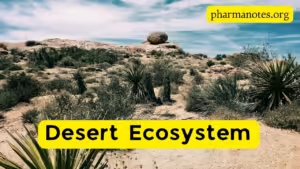Desert Ecosystem

Intended Learning Outcomes
At the end of this Lecture, students will be able to
• Explain Desert ecosystem
• Discuss the characteristic features of Desert ecosystem
• Discuss the structure and functional of the Desert ecosystem
Desert Ecosystem
• Desert and semi-arid lands are highly specialized and sensitive ecosystems that are easily destroyed by human activities
• The species of these dry areas can live only in this specialised habitat
What is a desert or a semi-arid ecosystem?
• Deserts and semi-arid areas are located in Western India and the Deccan Plateau
• Climate in these vast tracts is extremely dry
• There are also cold deserts such as in Ladakh, which are located in the high plateaus of the Himalayas
• Most typical desert landscape that is seen in Rajasthan is in the Thar Desert
• This has sand dunes
• There are also areas covered with sparse grasses and a few shrubs, which grow if it rains
• In most areas of the Thar the rainfall is scanty and sporadic
• In the adjoining semi-arid tract the vegetation consists of a few shrubs and
• Thorny trees such as kher and babul
• Great and Little Rann of Kutch are highly specialised arid ecosystems
• In the summers they are similar to a desert landscape, however as these are low-lying areas near the sea, they get converted to salt marshes during the monsoons
• During this period they attract an enormous number of aquatic bird’s such
• Great Rann is famous, as it is the only known breeding colony of the Greater and Lesser Flamingos in our country
• Little Rann of Kutch is the only home of the wild as in India
• Desert and semi-arid regions have a number of highly specialized insects and reptiles
• Animals include the Indian wolf, desert cat, desert fox and birds such as the Great Indian Bustard and Florican
• Some of the commoner birds include partridges, quails and sandgrouse
How are desert and semi-arid ecosystems used?
• Areas of scanty vegetation with semi-arid scrubland have been used for camel, cattle and goat grazing in Rajasthan and Gujarat and for sheep grazing in the Deccan Plateau
• Areas that have a little moisture, such as along the watercourses have been used for growing crops such as jowar and bajra
• Natural grasses and local varieties of crops have adapted to growing at very low moisture levels
• These can be used for genetic engineering and developing arid land crops for the future
What are the threats to desert ecosystems?
• Several types of development strategies as well as human population growth have begun to affect the natural ecosystem of the desert and semi-arid land
• Conversion of these lands through extensive irrigation systems has changed several of the natural characteristics of this region
• Canal water evaporates rapidly bringing the salts to the surface
• The region becomes highly unproductive as it becomes saline
• Pulling excessive groud water from tube wells lowers the water table
• Thus human activities destroy the naturalness of this unique ecosystem
• The special species that evolved here over millions of years may soon become extinct
How can desert ecosystems be conserved?
• Desert ecosystems are extremely sensitive
• Their ecological balance that forms a habitat for their plants and animals is easily disturbed
• Desert people have traditionally protected their meagre water resources
• The Bishnois in Rajasthan are known to have protected their Khejdi trees and the blackbuck antelope for several generations
• The tradition began when the ruler of their region ordered his army to cut down trees for his own use
• Several Bishnois were said to have been killed while trying to protect their trees
• There is an urgent need to protect residual patches of this ecosystem within National Parks and Wildlife Sanctuaries in desert and semi-arid areas
• The Indira Gandhi Canal in Rajasthan is destroying this important natural arid ecosystem, as it will convert the region into intensive agriculture
• In Kutch, areas of the little Rann, which is the only home of the Wild Ass, will be destroyed by the spread of salt works
• Development Projects alter the desert and arid landscape
• There is a sharp reduction in the habitat available for its specialised species bringing them to the verge of extinction
• We need a sustainable form of development that takes the special needs of the desert into account
Summary
• Desert and semi-arid lands are highly specialised and sensitive ecosystems that are easily destroyed by human activities
• Climate in these vast tracts is extremely dry
• Great and Little Rann of Kutch are highly specialised arid ecosystems
• Human activities destroy the naturalness of this unique ecosystem
Also, Visit:
B. Pharma Notes | B. Pharma Notes | Study material Bachelor of Pharmacy pdf